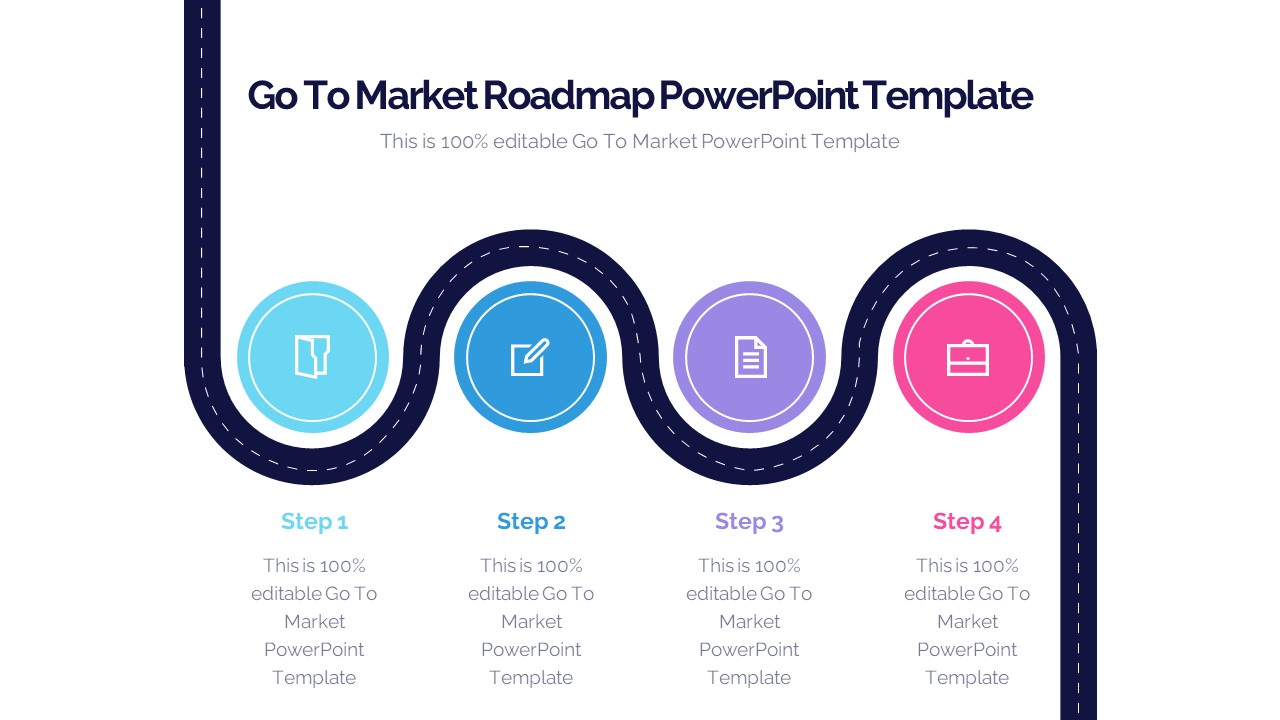Introducing our Go-To-Market Roadmap PowerPoint Template, the ultimate ppt for businesses and marketers aiming to conquer markets with precision and strategy. This template category is specially designed to assist you in crafting compelling presentations that outline your product launch or market expansion plan.
Navigating the complexities of a go-to-market strategy has never been easier. Our template includes a range of professionally crafted slides, each tailored to help you map out your journey to success. From market analysis and customer segmentation to distribution channels and launch timelines, these templates cover it all.
What sets this template apart is its versatility and ease of use. You can effortlessly customize it to match your branding, incorporating your company’s colors, fonts, and logos. The included graphics and icons are editable and scalable, ensuring your presentation looks crisp and professional on any screen.
Whether you’re presenting to investors, stakeholders, or your internal team, this Go-To-Market Roadmap PowerPoint Template is your secret weapon for making a lasting impact. It streamlines your communication, ensuring that everyone is aligned with your strategy and objectives.
Elevate your go-to-market game with this template and take a confident step toward market domination.
Features:
- Completely editable in terms of shape, color, size and text
- This template has a built in color theme which is unaffected by copy-pasting
- Includes an icon family with 135 unique completely editable icons
- Drag and drop image placeholder
- Completely editable (using spreadsheet) data-driven charts for displaying statistics
- Completely editable vector graphics
Supports
Microsoft PowerPoint 2010, 2011, 2013, 2016
MacOffice 2016, MacOffice 365, Keynote, Google Slides
Use Cases For Go To Market Roadmap PowerPoint Template
- Product Launch: Strategically plan and execute product launches by outlining key milestones, marketing strategies, and sales objectives. Ensure a coordinated approach across teams and channels for a successful market entry.
- Market Expansion: Expand into new markets with confidence by visualizing market entry strategies, target demographics, and expansion timelines. Identify opportunities and challenges to effectively penetrate and grow in new territories.
- Campaign Planning: Develop comprehensive marketing campaigns with clear objectives, timelines, and deliverables. Coordinate efforts across marketing channels, including digital, social media, and traditional advertising, to maximize reach and impact.
- Sales Strategy: Align sales efforts with overarching business goals by outlining sales strategies, territories, and target customer segments. Provide sales teams with a roadmap to effectively engage prospects, generate leads, and drive conversions.
- Channel Partnerships: Foster strategic partnerships with distributors, resellers, and other channel partners by defining partnership objectives, terms, and timelines. Facilitate collaboration and alignment to maximize mutual benefits and achieve shared goals.
- Product Lifecycle Management: Manage product lifecycles effectively by mapping out product development stages, feature releases, and end-of-life strategies. Ensure smooth transitions between product versions and maximize product value throughout its lifecycle.
- Competitive Analysis: Conduct competitive analysis and benchmarking by comparing your go-to-market strategies with competitors. Identify strengths, weaknesses, and opportunities to differentiate your offerings and gain a competitive edge.
- Customer Acquisition: Develop targeted customer acquisition strategies by defining customer personas, acquisition channels, and conversion funnels. Optimize marketing and sales efforts to attract, engage, and convert potential customers effectively.
- Brand Building: Build brand awareness and equity by creating cohesive branding strategies and messaging frameworks. Develop brand positioning, identity, and communication strategies to resonate with target audiences and drive brand loyalty.
- Strategic Alliances: Form strategic alliances and collaborations with industry partners, suppliers, or complementary businesses. Define partnership objectives, activities, and timelines to leverage synergies and create mutual value.
- Product Roadmapping: Align product development efforts with market demands and customer needs by mapping out product roadmaps. Prioritize feature releases, enhancements, and updates to meet evolving market requirements and maintain competitive advantage.
- Go-To-Market Planning: Develop comprehensive go-to-market plans for new products, services, or initiatives. Define target markets, value propositions, distribution channels, and promotional strategies to ensure successful market entry and adoption.
- Launch Readiness: Ensure launch readiness by coordinating cross-functional teams and activities, including product development, marketing, sales, and customer support. Mitigate risks and address potential obstacles to ensure a smooth and successful launch.
- Market Segmentation: Segment target markets based on demographic, geographic, psychographic, or behavioral factors. Develop tailored go-to-market strategies and messaging to address the unique needs and preferences of each market segment.
- Product Positioning: Define clear product positioning and messaging strategies to differentiate your offerings in the marketplace. Communicate value propositions, benefits, and competitive advantages effectively to resonate with target customers.





Chassey –
Fulfil my need perfectly.
Clark –
Good ppt